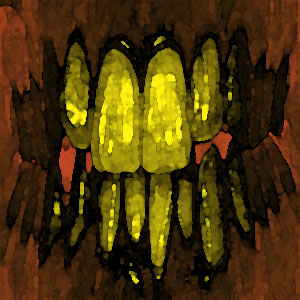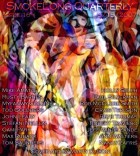The car crash and the gallery. Either one could work to make a fine flash piece. Part of what fascinates me as reader and editor is the way these seemingly disparate parts of a story find each other. How did car crash meet art gallery?
Putting disparate parts together is one of the things fiction writers do (poets as well). Although a car crash and an art gallery don’t approach the level of Keats’ negative capability, it’s sort of along that same continuum. In this case, actually, their conjunction is probably more of a cliché: Santa Fe/art gallery. Kind of like Memphis/music. That’s okay because couples and families engage in vacation clichés. You can also think of this as plot (car crash) and theme (art gallery). The truth is that I didn’t put very much thought into it, at least conscious thought, but that’s not to say my mind wasn’t working. I don’t think we’ve come up with a fully satisfactory word to describe the cognitive instinct that takes over when we write.
“It was as simple as that.” I love that line. For me, it gets at something central. What do you make of this line? Is there a way to “weight” lines, in the way this line feels weighted? Or is that “weighting” particular to each reader?
I like your use of the word ‘weight.’ I think that describes it perfectly. I believe weighting becomes particular to the reader if the writer hasn’t particularly done his or her job. At readings, for example, you sometimes run into this problem: the piece’s rhythm is much different (and better) vocalized than when it’s read on the page (which is why, as fiction editor of The Kenyon Review, I’m always a little frightened when I ask someone to send me the piece they just read). In my story’s case, the line is weighted because it’s a simple sentence that comes after several long ones that involve a series of actions and a slightly extended metaphor. So, syntactically speaking, it’s nice to round that off with a simple sentence. It acts as a kind of cleanser. You’re also at the end of the story here. Endings can involve simple sentences or complex ones, but always you’re striving to get that rhythmic weight right. In the last workshop I taught, I cut up a bunch of sentences from stories and the participants had to guess which were opening lines, middle lines, and ending lines. The ending lines were the most revealing because of this issue of weight and rhythm.
What are the essential rules to know for short/flash fiction? In writing this piece, what rules were you most conscious of following and/or breaking?
I don’t know too much about the rules of flash fiction, but Pam Painter is really an expert on it. We taught together once at The Kenyon Review summer workshop (gotta get my plugs in), and I learned a lot from her. She thinks that the arc in flash fiction is already peaking and winding down as the story begins. That’s an interesting contradiction to think about. The immediate peaking in flash fiction sets it apart from a longer short story. In my story, the addition of “too” at the end of the first line gets at that peaking action very quickly. As far as violating rules, in a longer short story I couldn’t have continued too much longer in the summarizing voice I adopted. Pretty soon I’d have to give the reader a dramatized scene.
As the fiction editor of The Kenyon Review, you must see a lot of stories. What trends are you seeing in contemporary fiction? Where do you see flash fiction fitting into the contemporary literary landscape?
It’s clear that a lot of writers are turning to flash fiction. Flash fiction is fun: fun to write and fun to read. It’s a great forum to test out writing styles. There are some practical reasons as well. New writers might believe they have a better chance publishing shorter stuff—hey, it’s only two pages, come on, you can publish it! Flash fiction, frankly, can also hide some flaws that may become apparent in a 20-page story: character development, dialogue, dramatized scenes—these are the more prosaic necessities in a long story. The Kenyon Review doesn’t publish very much flash fiction. One main reason is that so many lit mags are turning to the short short form. They may have some financial reasons for this as well as aesthetic. Regardless, the long story still needs to have a welcoming home. In the 2007 Novel and Short Story Writer’s Market, there’s an interview of editors about this very issue. It seems I’m the only editor included who’s not moving toward the short short.
At the recent AWP conference, a number of writers talked about their old flames, books that have influenced them during a formative time in their lives—and ones they return to for lessons in writing and, of course, life. Discuss your old flame, both what it meant to you then and what it means to you now.
Yes, I saw that AWP panel about “old flames” and wanted to attend. It looked very interesting. My old flame, from 8th grade, is Pearl Buck’s The Good Earth. Unlike a couple of other old flames, which shall remain nameless, this book has held up for me into adulthood. I love the writing of it, the simple sentences and the way the simple sentences sometimes become run-ons. The dialogue is very modern. I love the characters. The book made me cry. These might have been my first literary tears, which is why the tragedy and sadness of O-lan, one of the main characters, has remained so vivid. The book has tremendous depth and scope and a huge heart as it follows several lives from youth to old age.



 The core workshop of SmokeLong Fitness is all in writing, so you can take part from anywhere at anytime. We are excited about creating a supportive, consistent and structured environment for flash writers to work on their craft in a community. We are thrilled and proud to say that our workshop participants have won, placed, or been listed in every major flash competition. Community works.
The core workshop of SmokeLong Fitness is all in writing, so you can take part from anywhere at anytime. We are excited about creating a supportive, consistent and structured environment for flash writers to work on their craft in a community. We are thrilled and proud to say that our workshop participants have won, placed, or been listed in every major flash competition. Community works.